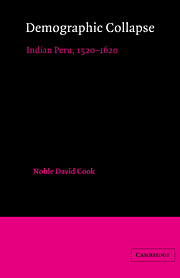Book contents
- Frontmatter
- Contents
- List of tables, figures, and maps
- Preface
- Introduction: The problem in perspective
- Part I Peru's preconquest population
- 1 The ecological approach
- 2 Population and archaeology
- 3 Depopulation ratios
- 4 Estimates from social organization
- 5 Disease mortality models
- 6 Census projections
- 7 Conclusion
- Part II Demographic collapse
- Abbreviations used in notes
- Notes
- Bibliography
- Index
- Titles in the series
1 - The ecological approach
Published online by Cambridge University Press: 02 December 2009
- Frontmatter
- Contents
- List of tables, figures, and maps
- Preface
- Introduction: The problem in perspective
- Part I Peru's preconquest population
- 1 The ecological approach
- 2 Population and archaeology
- 3 Depopulation ratios
- 4 Estimates from social organization
- 5 Disease mortality models
- 6 Census projections
- 7 Conclusion
- Part II Demographic collapse
- Abbreviations used in notes
- Notes
- Bibliography
- Index
- Titles in the series
Summary
Surprisingly enough no authors (except for Kosok … in estimating coastal population) have used the carrying capacity of the present area encompassed as a check on maximum population.
Richard Schaedel, “Formation of the Inca State,” p. 123Carrying capacity is, of course, an optimal concept – what could be if all constituent factors operated optimally.
David Henige, “Contact Population of Hispaniola,” p. 233Human populations cannot expand forever. Densities are ultimately limited by the environment's ability to sustain them. One of the principal limits to population is the supply of essential foodstuffs. The population of Europe in the years prior to the Black Death in the mid-fourteenth century appears to have surpassed the limit and was suffering from a series of inadequate harvests and famine before the devastating epidemics of 1348. The population of Central Mexico under the Aztecs also seems to have exceeded the carrying capacity of its agricultural economy. Sherburne F. Cook has suggested that extensive practice of human sacrifice by the Aztecs was an implicit societal attempt to redress the balance between inhabitants and land. Study of the maximum carrying capacity of an ecological system can assist the researcher in establishing population bounds, but, as we shall see, there are many variables in the equation, and the estimated limits are far from precise.
The human factor adds a major complication in assessing the ecological potential of a region. No two groups of people are exactly the same.
- Type
- Chapter
- Information
- Demographic CollapseIndian Peru, 1520–1620, pp. 14 - 29Publisher: Cambridge University PressPrint publication year: 1982



